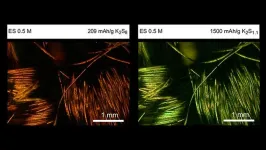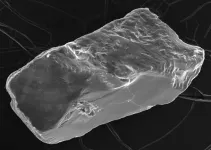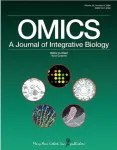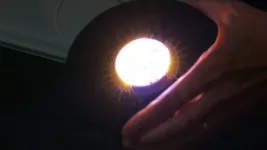(Press-News.org) Renewable energy sources like wind and solar are critical to sustaining our planet, but they come with a big challenge: they don't always generate power when it's needed. To make the most of them, we need efficient and affordable ways to store the energy they produce, so we have power even when the wind isn't blowing or the sun isn't shining.
Columbia Engineering material scientists have been focused on developing new kinds of batteries to transform how we store renewable energy. In a new study published September 5 by Nature Communications, the team used K-Na/S batteries that combine inexpensive, readily-found elements -- potassium (K) and sodium (Na), together with sulfur (S) -- to create a low-cost, high-energy solution for long-duration energy storage.
“It’s important that we be able to extend the length of time these batteries can operate, and that we can manufacture them easily and cheaply,” said the team’s leader Yuan Yang, associate professor of materials science and engineering in the Department of Applied Physics and Mathematics at Columbia Engineering. “Making renewable energy more reliable will help stabilize our energy grids, reduce our dependence on fossil fuels, and support a more sustainable energy future for all of us.”
New electrolyte helps K-Na/S batteries store and release energy more efficiently
There are two major challenges with K-Na/S batteries: they have a low capacity because the formation of inactive solid K2S2 and K2S blocks the diffusion process and their operation requires very high temperatures (>250 oC) that need complex thermal management, thus increasing the cost of the process. Previous studies have struggled with solid precipitates and low capacity and the search has been on for a new technique to improve these types of batteries.
Yang’s group developed a new electrolyte, a solvent of acetamide and ε-caprolactam, to help the battery store and release energy. This electrolyte can dissolve K2S2 and K2S, enhancing the energy density and power density of intermediate-temperature K/S batteries. In addition, it enables the battery to operate at a much lower temperature (around 75°C) than previous designs, while still achieving almost the maximum possible energy storage capacity.
“Our approach achieves nearly theoretical discharge capacities and extended cycle life. This is very exciting in the field of intermediate-temperature K/S batteries,” said the study’s co-first author Zhenghao Yang, a PhD student with Yang.
Pathway to a sustainable energy future
Yang’s group is affiliated with the Columbia Electrochemical Energy Center (CEEC), which takes a multiscale approach to discover groundbreaking technology and accelerate commercialization. CEEC joins together faculty and researchers from across the School of Engineering and Applied Science who study electrochemical energy with interests ranging from electrons to devices to systems. Its industry partnerships enable the realization of breakthroughs in electrochemical energy storage and conversion.
Planning to scale up
While the team is currently focused on small, coin-sized batteries, their goal is to eventually scale up this technology to store large amounts of energy. If they are successful, these new batteries could provide a stable and reliable power supply from renewable sources, even during times of low sun or wind. The team is now working on optimizing the electrolyte composition.
END
Technology could boost renewable energy storage
Columbia Engineers develop new powerful battery "fuel" -- an electrolyte that not only lasts longer but is also cheaper to produce.
2024-09-16
ELSE PRESS RELEASES FROM THIS DATE:
Introducing SandAI: A tool for scanning sand grains that opens windows into recent time and the deep past
2024-09-16
Stanford researchers have developed an artificial intelligence-based tool – dubbed SandAI – that can reveal the history of quartz sand grains going back hundreds of millions of years. With SandAI, researchers can tell with high accuracy if wind, rivers, waves, or glacial movements shaped and deposited motes of sand.
The tool gives researchers a unique window into the past for geological and archeological studies, especially for eras and environments where few other clues, such as fossils, are preserved ...
Critical crops’ alternative way to succeed in heat and drought
2024-09-16
Scientists have discovered that certain plants can survive stressful, dry conditions by controlling water loss through their leaves without relying on their usual mechanism - tiny pores known as ‘stomata’.
Nonstomatal control of transpiration in maize, sorghum, and proso millet – all C4 crops which are critical for global food security – gives these plants an advantage in maintaining a beneficial microclimate for photosynthesis within their leaves.
This allows the plants to absorb carbon dioxide ...
Students with multiple marginalized identities face barriers to sports participation
2024-09-16
MINNEAPOLIS/ST. PAUL (09/16/2024) — The U.S. Department of Health and Human Services Healthy People 2030 plan sets a national objective to increase youth sports participation from 50% to 63% over the next five years. For adolescents, staying active offers benefits to their overall health and their social and academic lives. However, the number of youths participating in physical activity and sports is on the decline. While participation gaps based on single social identities ...
Purdue deep-learning innovation secures semiconductors against counterfeit chips
2024-09-16
WEST LAFAYETTE, Ind. — Researchers in Purdue University’s College of Engineering have developed a patent-pending optical counterfeit detection method for chips used in semiconductor devices.
The Purdue method is called RAPTOR, or residual attention-based processing of tampered optical responses. It leverages deep learning to identify tampering. It improves upon traditional methods, which face challenges in scalability and discriminating between natural degradation and adversarial tampering.
Alexander Kildishev, professor in the Elmore ...
Will digital health meet precision medicine? A new systematic review says it is about time
2024-09-16
A new systematic review of pharmacogenomics clinical decision support systems used in clinical practice in the peer-reviewed OMICS: A Journal of Integrative Biology suggests that these e-health tools can help accelerate pharmacogenomics, precision/personalized medicine, and digital health emergence in everyday clinical practice worldwide. Click here to read the article now.
Anastasia Farmaki, MSc, from the Centre for Research and Technology Hellas, Thessaloniki, and coauthors in Greece, conducted a systematic review that examined and mapped the pharmacogenomics-clinical decision support ...
Improving eye tracking to assess brain disorders
2024-09-16
A University of Houston engineering team has developed wearable sensors to examine eye movement to assess brain disorders or damage to the brain. Many brain diseases and problems show up as eye symptoms, often before other symptoms appear.
You see, eyes are not merely a window into the soul, as poets would have it. These incredibly precious organs are also an extension of the brain and can provide early warning signs of brain-related disorders and information on what causes them. Examining the eyes can also help track the progression and symptoms of physical and mental shocks to the brain.
Researchers say ...
Hebrew University’s professor Haitham Amal is among a large $17 million grant consortium for pioneering autism research
2024-09-16
Hebrew University of Jerusalem is proud to announce that Professor Haitham Amal is among a large $17M grant consortium for pioneering autism research. This grant is part of an American funding initiative awarded by the California Institute for Regenerative Medicine (CIRM), aimed at advancing cutting-edge autism studies.
A world-renowned expert in nitric oxide and brain disorders, Professor Amal has made groundbreaking discoveries in autism research. His team was the first to identify a direct link between nitric oxide levels in the brain and autism spectrum disorder (ASD), a finding with profound implications for the ...
Scientists mix sky’s splendid hues to reset circadian clocks
2024-09-16
Those mesmerizing blue and orange hues in the sky at the start and end of a sunny day might have an essential role in setting humans’ internal clocks.
In new research from the University of Washington in Seattle, a novel LED light that emits alternating wavelengths of orange and blue outpaced two other light devices in advancing melatonin levels in a small group of study participants.
Published in the Journal of Biological Rhythms, the finding appears to establish a new benchmark in humans’ ability to influence their circadian rhythms, and reflects an effective new approach to counteract seasonal affective disorder (SAD).
A ...
Society for Neuroscience 2024 Outstanding Career and Research Achievements
2024-09-16
Embargoed until Monday, September 16, noon EDT Contact: development@sfn.org
CHICAGO – The Society of Neuroscience (SfN) will honor leading researchers whose groundbreaking work has transformed neuroscience — including the understanding of pain, addiction, stress, synaptic transport, vision, and sleep — with this year’s Outstanding Career and Research Achievement Awards. The awards will be presented during SfN’s annual ...
Society for Neuroscience 2024 Early Career Scientists’ Achievements and Research Awards
2024-09-16
Embargoed until Monday, September 16, noon EDT Contact: development@sfn.org
CHICAGO – The Society for Neuroscience (SfN) will honor nine early career researchers whose work will be presented during Neuroscience 2024, SfN's annual meeting.
“Early career researchers are often the ones who bring fresh ideas and perspectives to the field,” said SfN President Marina Picciotto. “These awardees and their novel approaches to microscopy, machine learning, circuits and behavior ...
LAST 30 PRESS RELEASES:
Why nail-biting, procrastination and other self-sabotaging behaviors are rooted in survival instincts
Regional variations in mechanical properties of porcine leptomeninges
Artificial empathy in therapy and healthcare: advancements in interpersonal interaction technologies
Why some brains switch gears more efficiently than others
UVA’s Jundong Li wins ICDM’S 2025 Tao Li Award for data mining, machine learning
UVA’s low-power, high-performance computer power player Mircea Stan earns National Academy of Inventors fellowship
Not playing by the rules: USU researcher explores filamentous algae dynamics in rivers
Do our body clocks influence our risk of dementia?
Anthropologists offer new evidence of bipedalism in long-debated fossil discovery
Safer receipt paper from wood
Dosage-sensitive genes suggest no whole-genome duplications in ancestral angiosperm
First ancient human herpesvirus genomes document their deep history with humans
Why Some Bacteria Survive Antibiotics and How to Stop Them - New study reveals that bacteria can survive antibiotic treatment through two fundamentally different “shutdown modes”
UCLA study links scar healing to dangerous placenta condition
CHANGE-seq-BE finds off-target changes in the genome from base editors
The Journal of Nuclear Medicine Ahead-of-Print Tip Sheet: January 2, 2026
Delayed or absent first dose of measles, mumps, and rubella vaccination
Trends in US preterm birth rates by household income and race and ethnicity
Study identifies potential biomarker linked to progression and brain inflammation in multiple sclerosis
Many mothers in Norway do not show up for postnatal check-ups
Researchers want to find out why quick clay is so unstable
Superradiant spins show teamwork at the quantum scale
Cleveland Clinic Research links tumor bacteria to immunotherapy resistance in head and neck cancer
First Editorial of 2026: Resisting AI slop
Joint ground- and space-based observations reveal Saturn-mass rogue planet
Inheritable genetic variant offers protection against blood cancer risk and progression
Pigs settled Pacific islands alongside early human voyagers
A Coral reef’s daily pulse reshapes microbes in surrounding waters
EAST Tokamak experiments exceed plasma density limit, offering new approach to fusion ignition
Groundbreaking discovery reveals Africa’s oldest cremation pyre and complex ritual practices
[Press-News.org] Technology could boost renewable energy storageColumbia Engineers develop new powerful battery "fuel" -- an electrolyte that not only lasts longer but is also cheaper to produce.




